Under rainy skies, the Indian elephants trot across the meadow behind the elephant house. Yashoda in front, Shandra in the middle and the six-year-old calf Corny at the end. They hold on to their tails with their trunks. The current animal population is surveyed for the annual animal inventory at Hagenbeck Zoo. The elephants also have to be weighed on the platform scales from ESSMANN | Waagen & Automation.
Corny, the youngest of the trio at eight years old, is a real lightweight. “1655 kilograms” reads zoo vet Dr. Michael Flügger from the display of the animal scales. It was custom-made and donated by the Hamburg-based family business ESSMANN | Waagen & Automation Horst Eßmann GmbH. “It is a particularly flat floor scale for free-standing installation, which has been specially galvanized – and is therefore suitable for animals,” explains Managing Director Manuela Eßmann. Yashoda, at 3548 kilograms, and even Shandra, at 4238 kilograms, one of the heaviest animals in the park, can now be weighed directly at the elephant house and no longer have to go to the beet scales at the feeding yard.
Weighing, measuring and counting is no fun pastime for zoos. “Based on the body measurements, we can make statements about the health of many animals,” says Dr. Flügger. Counting is more of an accounting exercise, as the keepers immediately record the data for every birth, new arrival or death. The scales were actually intended to be used for the birth of the elephant baby of the female elephant Thura.






